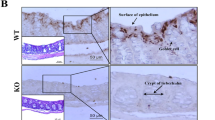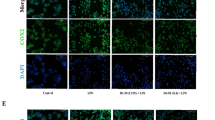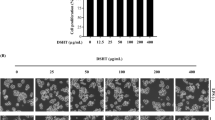Abstract
Aim:
To elucidate the anti-inflammatory potentials and underlying mechanisms of SM905, a novel artemisinin derivative, in lipopolysaccharide (LPS)-stimulated murine macrophage RAW 264.7 cells.
Methods:
Nitric oxide (NO) generation, cytokine production, and the protein expression levels of inducible nitric-oxide synthase (iNOS) and cyclooxygenase-2 (COX-2) were examined using a Griess assay, an enzyme-linked immunosorbent assay (ELISA) and a Western blotting assay, respectively. The mRNA expression was measured using real-time PCR. The phosphorylation of extracellular signal-regulated kinase1/2 (ERK1/2), p38, c-jun N-terminal kinase (JNK), and the degradation of IκBα were assessed by Western blotting analysis. The nuclear translocation of nuclear factor-κB (NF-κB) was observed using confocal microscopy.
Results:
Pretreatment with SM905 (0, 0.1, 1, and 10 μmol/L) suppressed LPS-induced NO, TNF-α, IL-1β, and IL-6 production, and decreased both protein and mRNA levels of iNOS and COX-2. The mRNA expression of LPS receptor Toll-like receptor 4 (TLR4) and myeloid differentiation protein-2 (MD-2) was not changed, while LPS-induced CD14 expression was slightly reduced after SM905 treatment. SM905 markedly decreased the activation of ERK1/2, p38 and JNK suppressed the degradation of IκBα, but did not modify the expression of interferon regulatory factor-1 (IRF-1), signal transducer and activator of transcription 1 (STAT1) or interferon-inducible protein-10 (IP-10). By using confocal microscopy, we further observed that NF-κB was correspondingly inhibited in SM905-treated cells.
Conclusion:
SM905 inhibited NO and pro-inflammatory cytokine production in LPS-stimulated RAW 264.7 cells and these effects are at least partially mediated through suppression of the MAPK and NF-κB signaling pathways.
Similar content being viewed by others
Log in or create a free account to read this content
Gain free access to this article, as well as selected content from this journal and more on nature.com
or
References
Stoy N . Macrophage biology and pathobiology in the evolution of immune responses: a functional analysis. Pathobiology 2001; 69: 179–211.
Guha M, Mackman N . LPS induction of gene expression in human monocytes. Cell Signal 2001; 13: 85–94.
O'Neill LA . Targeting signal transduction as a strategy to treat inflammatory diseases. Nat Rev Drug Discov 2006; 5: 549–63.
Akashi S, Shimazu R, Ogata H, Nagai Y, Takeda K, Kimoto M, et al. Cutting edge: cell surface expression and lipopolysaccharide signaling via the toll-like receptor 4-MD-2 complex on mouse peritoneal macrophages. J Immunol 2000; 164: 3471–5.
Lichtman SN, Wang J, Lemasters JJ . LPS receptor CD14 participates in release of TNF-alpha in RAW 264.7 and peritoneal cells but not in kupffer cells. Am J Physiol 1998; 275: G39–46.
Medvedev AE, Kopydlowski KM, Vogel SN . Inhibition of ipopolysaccharide-induced signal transduction in endotoxin-tolerized mouse macrophages: dysregulation of cytokine, chemokine, and toll-like receptor 2 and 4 gene expression. J Immunol 2000; 164: 5564–74.
Dunne A, O'Neill LA . Adaptor usage and Toll-like receptor signaling specificity. FEBS Lett 2005; 579: 3330–5.
Kawai T, Adachi O, Ogawa T, Takeda K, Akira S . Unresponsiveness of MyD88-deficient mice to endotoxin. Immunity 1999; 11: 115–22.
Kawai T, Takeuchi O, Fujita T, Inoue J, Muhlradt PF, Sato S, et al. Lipopolysaccharide stimulates the MyD88-independent pathway and results in activation of IFN-regulatory factor 3 and the expression of a subset of lipopolysaccharide-inducible genes. J Immunol 2001; 167: 5887–94.
Bjorkbacka H, Fitzgerald KA, Huet F, Li X, Gregory JA, Lee MA, et al. The induction of macrophage gene expression by LPS predominantly utilizes Myd88-independent signaling cascades. Physiol Genomics 2004; 19: 319–30.
Kracht M, Saklatvala J . Transcriptional and post-transcriptional control of gene expression in inflammation. Cytokine 2002; 20: 91–106.
Widmann C, Gibson S, Jarpe MB, Johnson GL . Mitogen-activated protein kinase: conservation of a three-kinase module from yeast to human. Physiol Rev 1999; 79: 143–80.
Means TK, Pavlovich RP, Roca D, Vermeulen MW, Fenton MJ . Activation of TNF-alpha transcription utilizes distinct MAP kinase pathways in different macrophage populations. J Leukoc Biol 2000; 67: 885–93.
Tak PP, Firestein GS . NF-kappaB: a key role in inflammatory diseases. J Clin Invest 2001; 107: 7–11.
Kamijo R, Harada H, Matsuyama T, Bosland M, Gerecitano J, Shapiro D, et al. Requirement for transcription factor IRF-1 in NO synthase induction in macrophages. Science 1994; 263: 1612–5.
Jacobs AT, Ignarro LJ . Lipopolysaccharide-induced expression of interferon-beta mediates the timing of inducible nitric-oxide synthase induction in RAW 264.7 macrophages. J Biol Chem 2001; 276: 47950–7.
Toshchakov V, Jones BW, Perera PY, Thomas K, Cody MJ, Zhang S, et al . TLR4, but not TLR2, mediates IFN-beta-induced STAT1alpha/beta-dependent gene expression in macrophages. Nat Immunol 2002; 3: 392–8.
Ohmori Y, Hamilton TA . Requirement for STAT1 in LPS-induced gene expression in macrophages. J Leukoc Biol 2001; 69: 598–604.
Lu L . Study on effect of Cordyceps sinensis and artemisinin in preventing recurrence of lupus nephritis. Zhongguo Zhong Xi Yi Jie He Za Zhi 2002; 22: 169–71. Chinese.
Noori S, Naderi GA, Hassan ZM, Habibi Z, Bathaie SZ, Hashemi SM . Immunosuppressive activity of a molecule isolated from Artemisia annua on DTH responses compared with cyclosporin A. Int Immunopharmacol 2004; 4: 1301–6.
Wang JX, Tang W, Shi LP, Wan J, Zhou R, Ni J, et al. Investigation of the immunosuppressive activity of artemether on T-cell activation and proliferation. Br J Pharmacol 2007; 150: 652–61.
Zhou WL, Wu JM, Wu QL, Wang JX, Zhou Y, Zhou R, et al. A novel artemisinin derivative, 3-(12-beta-artemisininoxy) phenoxyl succinic acid (SM735), mediates immunosuppressive effects in vitro and in vivo. Acta Pharmacol Sin 2005; 26: 1352–8.
Yang ZS, Wang JX, Zhou Y, Zuo JP, Li Y . Synthesis and immunosuppressive activity of new artemisinin derivatives. Part 2: 2-[12(beta or alpha)-dihydroartemisinoxymethyl(or 1'-ethyl)]phenoxyl propionic acids and esters. Bioorg Med Chem 2006; 14: 8043–9.
Yang ZS, Zhou WL, Sui Y, Wang JX, Wu JM, Zhou Y, et al. Synthesis and immunosuppressive activity of new artemisinin derivatives. 1. [12(beta or alpha)-Dihydroartemisininoxy]phen(ox)yl aliphatic acids and esters. J Med Chem 2005; 48: 4608–17.
Zhang JX, Wang JX, Zhang Y, Zuo JP, Wu JM, Sui Y, et al. Synthesis and immunosuppressive activity of new artemisinin derivatives containing polyethylene glycol group. Yao Xue Xue Bao 2006; 41: 65–70. Chinese.
Wang JX, Tang W, Yang ZS, Wan J, Shi LP, Zhang Y, et al. Suppressive effect of a novel water-soluble artemisinin derivative SM905 on T cell activation and proliferation in vitro and in vivo. Eur J Pharmacol 2007; 564: 211–8.
Wang JX, Tang W, Zhou R, Wan J, Shi LP, Zhang Y, et al. The new water-soluble artemisinin derivative SM905 ameliorates collagen-induced arthritis by suppression of inflammatory and Th17 responses. Br J Pharmacol 2008; 153: 1303–10.
Zhou R, Zheng SX, Tang W, He PL, Li XY, Yang YF, et al. Inhibition of inducible nitric-oxide synthase expression by (5R)-5-hydroxytriptolide in interferon-gamma- and bacterial lipopolysaccharide-stimulated macrophages. J Pharmacol Exp Ther 2006; 316: 121–8.
Nathan C, Xie QW . Regulation of biosynthesis of nitric oxide. J Biol Chem 1994; 269: 13725–8.
Aldieri E, Atragene D, Bergandi L, Riganti C, Costamagna C, Bosia A, et al. Artemisinin inhibits inducible nitric oxide synthase and nuclear factor NF-kB activation. FEBS Lett 2003; 552: 141–4.
Cuzzocrea S, Saadat F, Di Paola R, Mirshafiey A . Artemether: a new therapeutic strategy in experimental rheumatoid arthritis. Immunopharmacol Immunotoxicol 2005; 27: 615–30.
Dong YJ, Li WD, Tu YY . Effect of dihydro-qinghaosu on auto-antibody production, TNF alpha secretion and pathologic change of lupus nephritis in BXSB mice. Zhongguo Zhong Xi Yi Jie He Za Zhi 2003; 23: 676–9. Chinese.
Li WD, Dong YJ, Tu YY, Lin ZB . Dihydroarteannuin ameliorates lupus symptom of BXSB mice by inhibiting production of TNF-alpha and blocking the signaling pathway NF-kappa B translocation. Int Immunopharmacol 2006; 6: 1243–50.
Mirshafiey A, Saadat F, Attar M, Di Paola R, Sedaghat R, Cuzzocrea S . Design of a new line in treatment of experimental rheumatoid arthritis by artesunate. Immunopharmacol Immunotoxicol 2006; 28: 397–410.
Means TK, Lien E, Yoshimura A, Wang S, Golenbock DT, Fenton MJ . The CD14 ligands lipoarabinomannan and lipopolysaccharide differ in their requirement for Toll-like receptors. J Immunol 1999; 163: 6748–55.
Qureshi ST, Lariviere L, Leveque G, Clermont S, Moore KJ, Gros P, et al. Endotoxin-tolerant mice have mutations in Toll-like receptor 4 (Tlr4). J Exp Med 1999; 189: 615–25.
Johnson GL, Lapadat R . Mitogen-activated protein kinase pathways mediated by ERK, JNK, and p38 protein kinases. Science 2002; 298: 1911–2.
Su B, Karin M . Mitogen-activated protein kinase cascades and regulation of gene expression. Curr Opin Immunol 1996; 8: 402–11.
Lee HG, Kim H, Oh WK, Yu KA, Choe YK, Ahn JS, et al. Tetramethoxy hydroxyflavone p7F downregulates inflammatory mediators via the inhibition of nuclear factor kappaB. Ann N Y Acad Sci 2004; 1030: 555–68.
Acknowledgements
This work was supported by a grant from Shanghai Science and Technology Committee (No 06DZ19006) and the Knowledge Innovation Program of the Chinese Academy of Sciences (No SIMM0709QN-01).
Author information
Authors and Affiliations
Corresponding author
Rights and permissions
About this article
Cite this article
Wang, Jx., Hou, Lf., Yang, Y. et al. SM905, an artemisinin derivative, inhibited NO and pro-inflammatory cytokine production by suppressing MAPK and NF-κB pathways in RAW 264.7 macrophages. Acta Pharmacol Sin 30, 1428–1435 (2009). https://doi.org/10.1038/aps.2009.138
Received:
Accepted:
Published:
Issue date:
DOI: https://doi.org/10.1038/aps.2009.138
Keywords
This article is cited by
-
Biological Activities of Artemisinins Beyond Anti-Malarial: a Review
Tropical Plant Biology (2019)
-
Diminazene aceturate (Berenil) downregulates Trypanosoma congolense-induced proinflammatory cytokine production by altering phosphorylation of MAPK and STAT proteins
Immunologic Research (2019)
-
Artemisinin analogue SM934 ameliorates DSS-induced mouse ulcerative colitis via suppressing neutrophils and macrophages
Acta Pharmacologica Sinica (2018)
-
Water-soluble artemisinin derivatives as promising therapeutic immunosuppressants of autoimmune diseases
Cellular & Molecular Immunology (2017)
-
The pharmacological activities and mechanisms of artemisinin and its derivatives: a systematic review
Medicinal Chemistry Research (2017)



